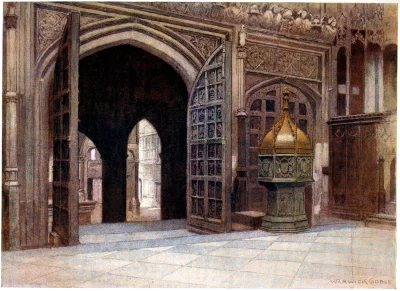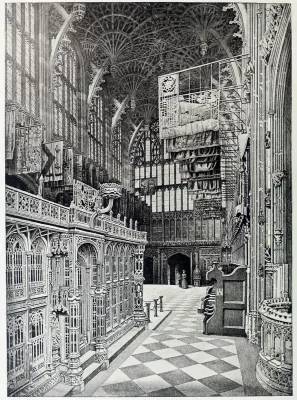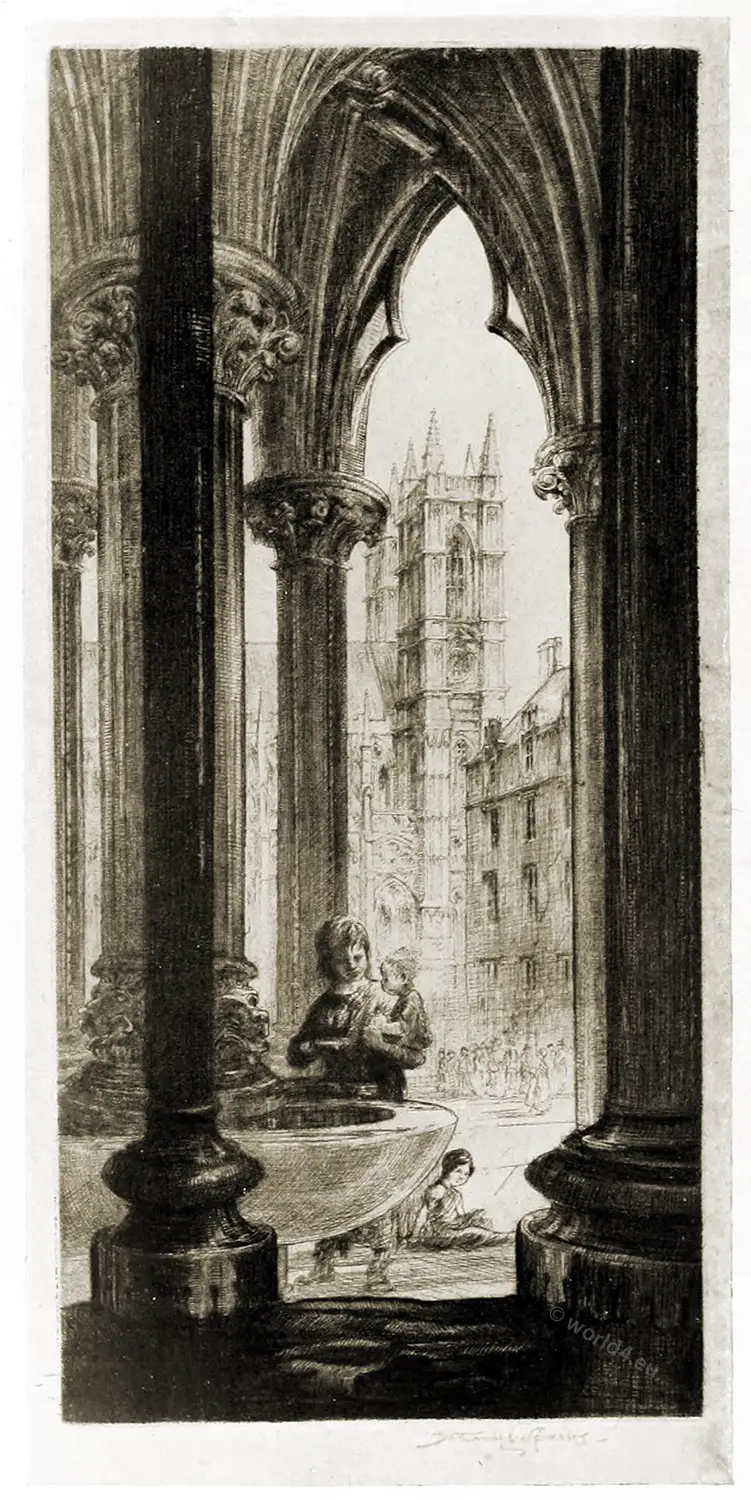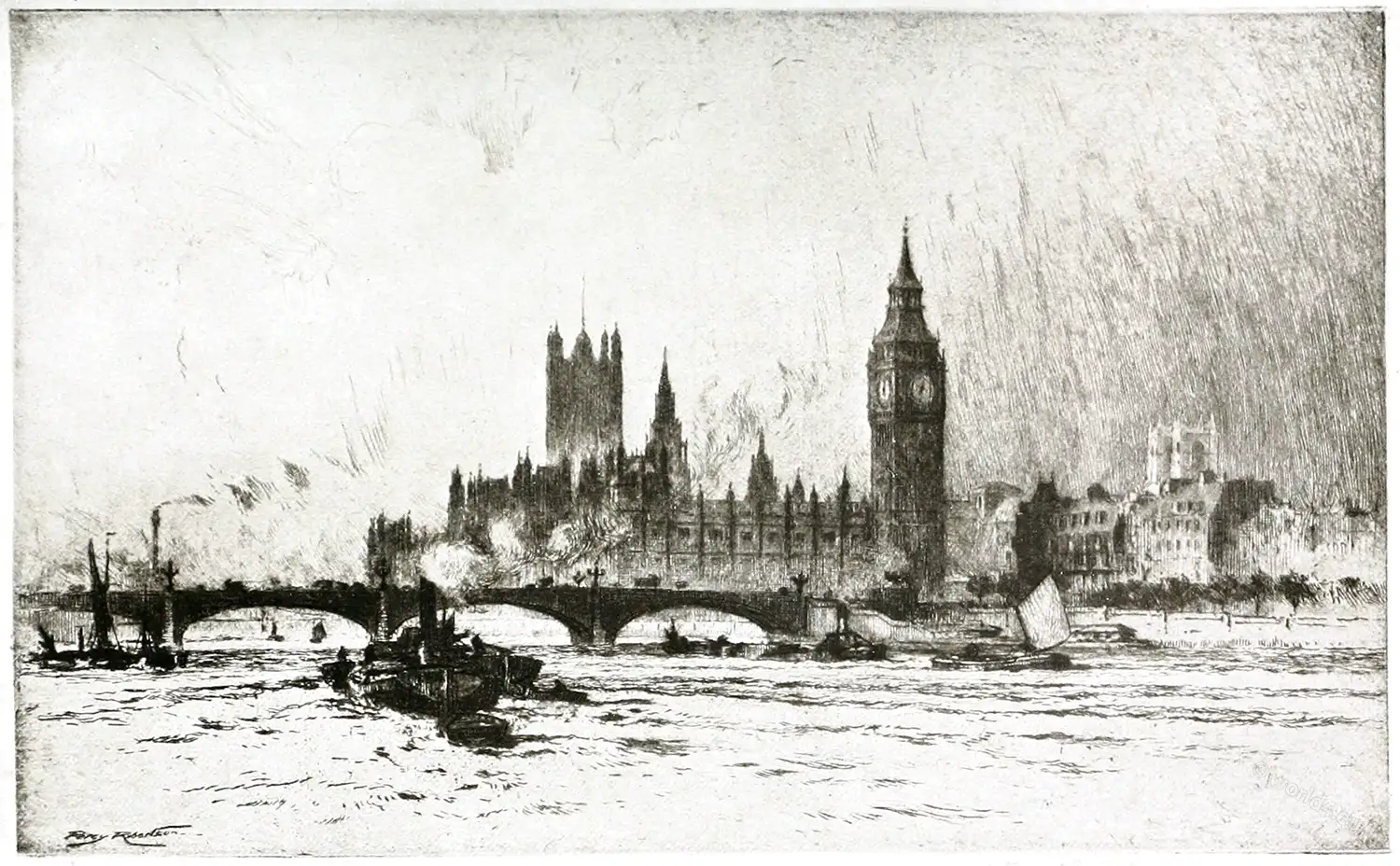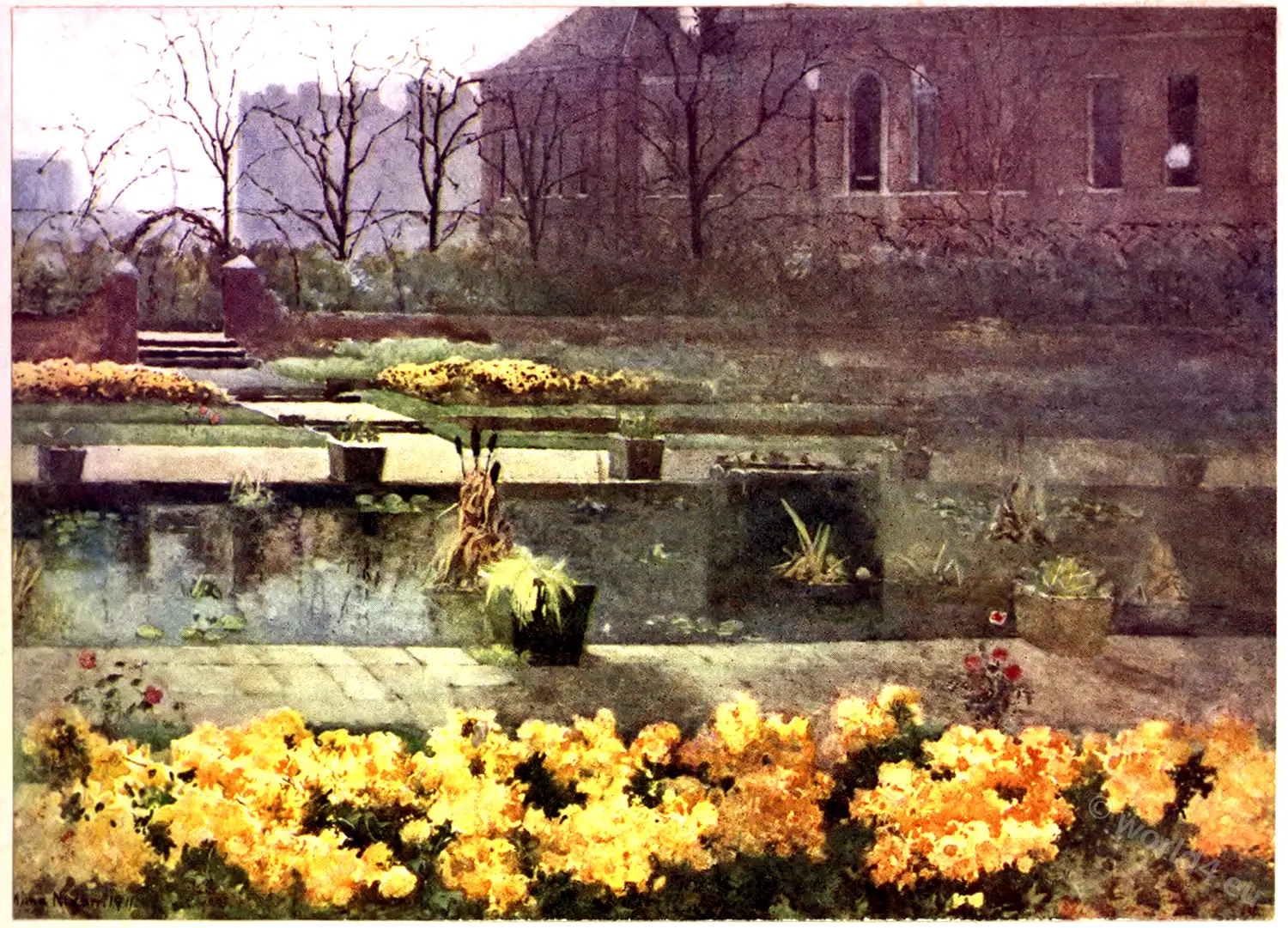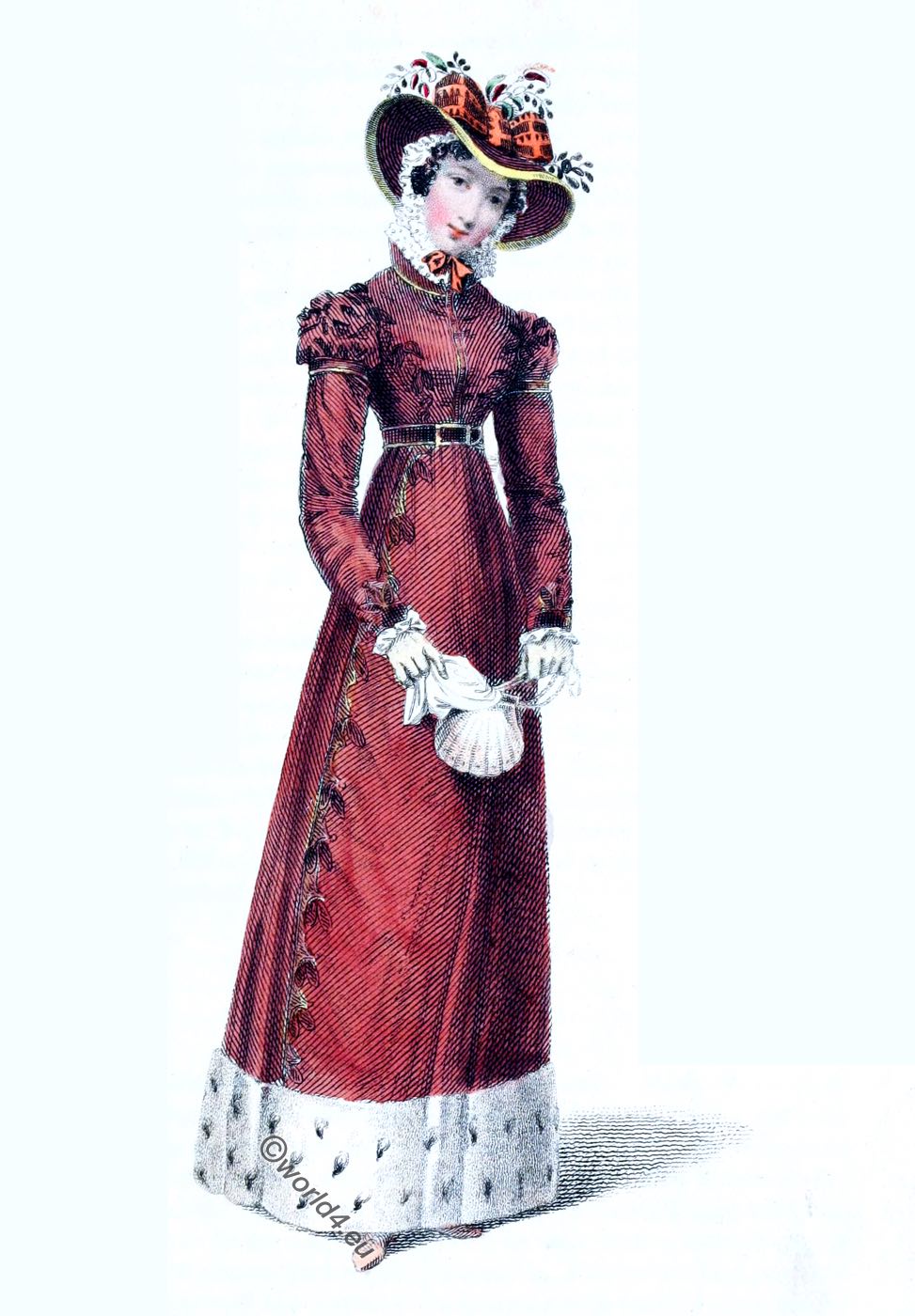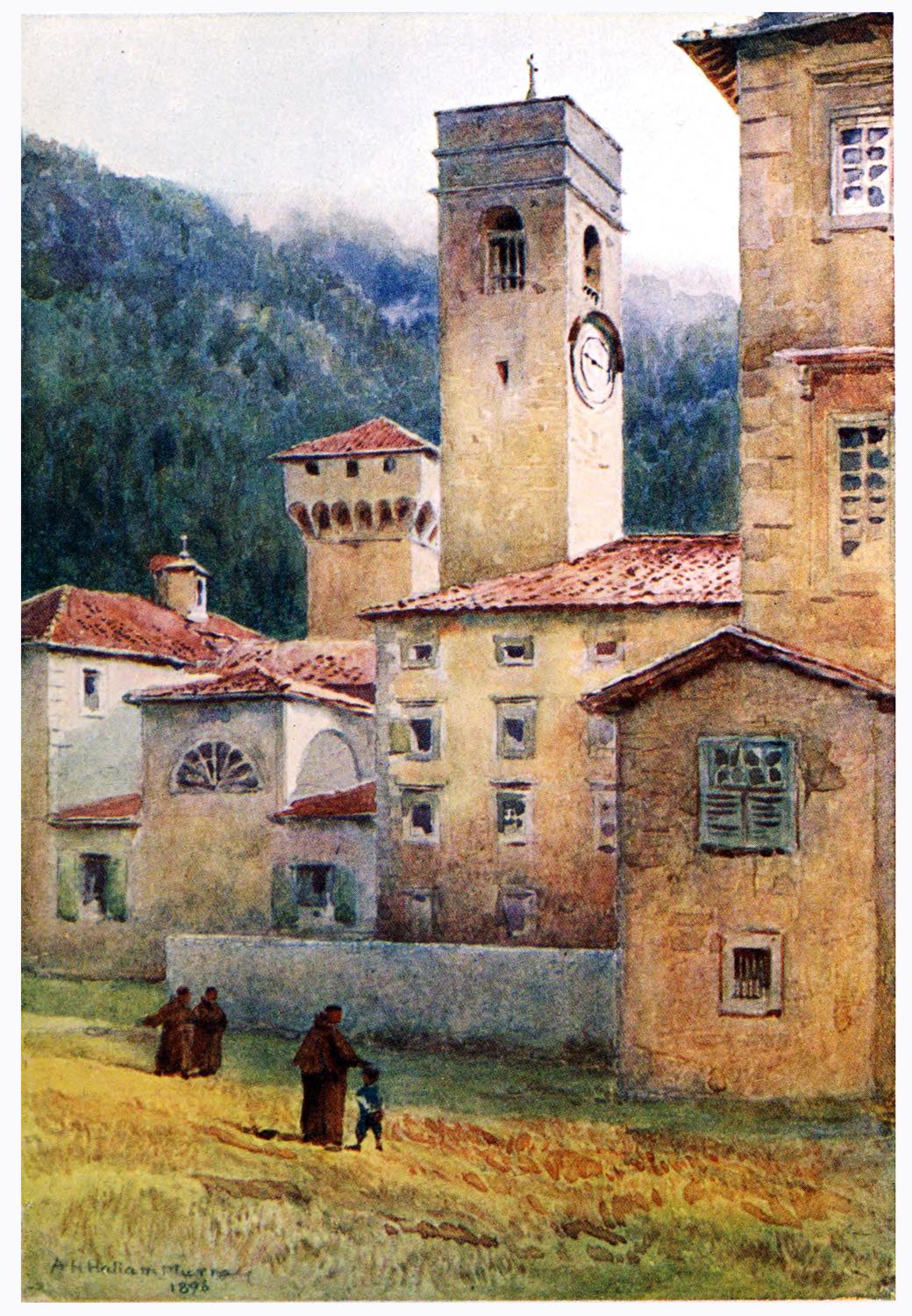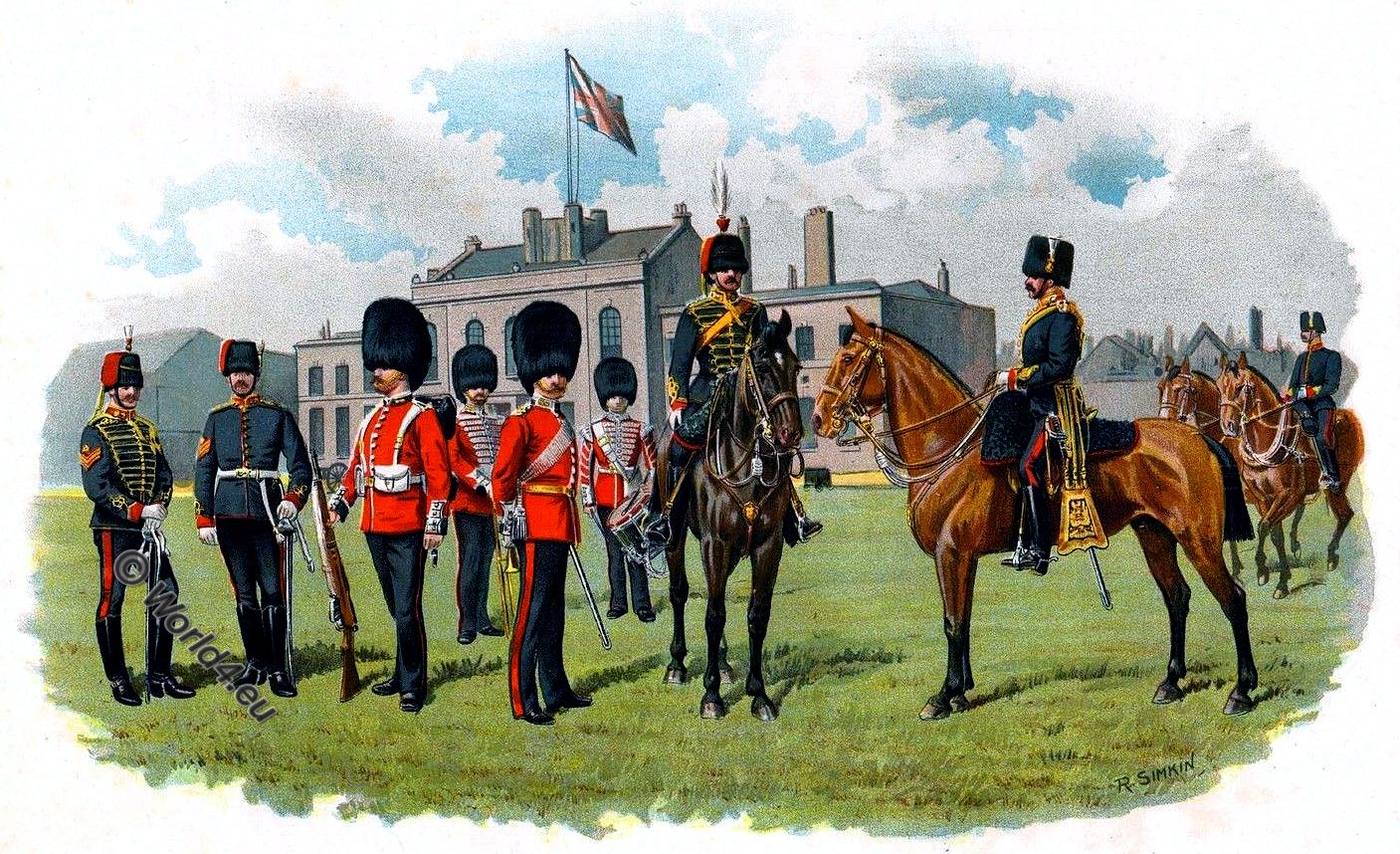THERE is but one Westminster. Other monasteries can claim better positions, or longer histories or perhaps some more wonderful or special feature of architecture; but none can recall historic memories like Westminster. It is a place the influence of which grows upon the mind the more it is known and the deeper it is studied.
The inspiring height of the nave and choir; the wonderful transept front; the broken pile of chapels over-topped by Henry VII’s crowning work; the interior so grand, so lofty, so graceful; the mysterious apsidal presbytery with its radiating chapels; all these features of the buildings and many more are less impressive even than the story which attaches to the walls, and which makes Westminster the most marvellous National Monument in the world. Here most of our kings were crowned, and here the most illustrious of our dead have found their last resting places.
The history of St Peter’s, Westminster, goes back into the mists of legend. Some have spoken of a church as existing on an island in the marsh lands of Westminster in the early days of British Christianity; others have put its foundation in the times of Ethelbert of Kent and the first Saxon converts, whilst William of Malmesbury gives the credit to St Mellitus himself.
One pretty and ancient story recounts the supernatural consecration of the church on the night before St Mellitus himself had arranged to perform the ceremony. Edric, the ferryman, it is said, on that night brought over the river from Lambeth a strange priest, who proved to be St Peter himself. Having ordered the fisherman to remain, the stranger betook himself to the humble church on Thorney island.

Thence in a brief time afterwards came the sound of singing, the gleam of tapers and the smell of incense, and the boatman venturing near, saw that an innumerable host from Heaven accompanied the Apostle in the ceremonial, whilst everything and person was illuminated by a supernatural light. The dedication having been accomplished, St Peter returned to the fisherman and declaring who he was, told him to go at daybreak and seek Mellitus and tell him that in proof of what he had done the bishop would find the marks of consecration crosses on the walls of the church.
As a further pledge St Peter bade the man sink his net in the river, and carry to the bishop one of the fish he should take. This he did, and captured such a netful of salmon that his boat could hardly contain them. For centuries after, in memory of this, the monks enjoyed a tithe of fish in the river from Jenlade to Staines, and every year a Thames salmon, the first of the season, was offered at the High Altar, and the fisherman who brought it was feasted in the hall. Only less wonderful than the tale of the dedication was the story that St John the Evangelist, in the pilgrimage which legend assigns to him until the second coming of our Lord, once foundbhis way to Westminster and trod the aisles of the church.
Hardly more certain than these pretty legends are the indications of the history of Thorney in Saxon times. The restorations supposed to have been made by Kings Offa and Edgar and even the charters of St Dunstan would appear to be open to some suspicion, although there is every reason to think that there was a monastic establishment already existing when King Edward the Confessor, the real founder of Westminster, built the first great church on Thorney island.
This great work the pious King undertook in place of a vow of pilgrimage to Rome, which he had made whilst in exile. At great cost the building was finished in a very few years, and it was altogether constructed in a style at that time new in England; it was the first Norman church ever erected in England. One writer describes it as a building “supported by many pillars and arches,” and Matthew Paris speaks of it as having been built “in a new style,” which, he adds, “served as a pattern much followed in the erection of other churches.” A description written at the time is as follows: “The principal area or nave of the church stood on lofty arches of hewn stone, jointed together in the neatest manner; the vault was covered with a strong double-arched roof of stone on both sides.
The cross, which embraced the choir, and by its transept supported a high tower in the middle, rose first with a low strong arch, and then swelled out with several winging staircases to the single wall, up to the wooden roof which was carefully covered with lead.” Besides the tower spoken of here St Edward’s church had two other towers at the western end and an apse at the eastern end. The Confessor also built the cloisters and a round Chapter House, whilst the undercroft of his dormitory still exists.
Having completed his church, Edward the Confessor summoned the nobility and clergy to the dedication. On Christmas Eve, 1065, however, before the date of the ceremony, he fell ill, and for that reason anticipated the day appointed for the solemnity. He had only time to hold it, and thus to witness the completion of his work, when he died on January 5, 1066, and was buried in the new church the following day, the feast of the Epiphany. Thirty-six years after, under Gilbert, the Norman abbot, the tomb was opened and the body found perfectly incorrupt.
The next great event in the history of the church of Westminster is the building erected by Henry III. In 1221 the new work was commenced at the Lady chapel, and the first stone was laid that year on Whitsun Eve by the King in person. The chapel then erected was subsequently taken down only to make way for that of Henry VII. Twenty-five years later, in 1245, the King, Henry III, pulled down the greater part of the church.
Matthew Paris says he ordered the east end, the tower and transept to be taken down and rebuilt in a more elegant style at his own expense. It is difficult to say what the work cost from first to last. In 1254, nine years after it had been begun, we have the barons of the exchequer ordered to apply to it the annual sum of 3,000 marks, and it is calculated that during the twelve years of the abbacy of Richard de Crokesley the sum of £29,600 was spent in money of that time.
The result we may rejoice in to-day. “It has” says a writer, “all that soaring loftiness, the wonderful charm and beauty of art, ever fresh to the eye and educated taste, which mark it out from all others, though they may be richer or vaster in dimension.” The most marked feature of the whole structure is the French arrangement of an apse and chapels radiating from the aisles, but in the carrying out of this design, Westminster shows an independent English judgement working on a foreign plan. The spaciousness of the triforia is said to have been “specially designed to accommodate thousands as witnesses of coronations and funerals of kings and queens in the chief national church.”
Matthew Paris gives a minute account of the translation to Westminster of a relic of the Precious Blood in 1247. This treasure had been brought back from the Holy Land, well authenticated, as a present to the King, and Henry determined to present it to Westminster. So the day after the feast of the translation of the Confessor, the King directed the London clergy to assemble at St Paul’s, where the reliquary had been previously placed, and to form there a procession in copes and surplices, with crosses and banners, etc. He himself, in the dress of a poor man and on foot, carried the reliquary. The monks of Westminster with many bishops, abbots and others came to meet him as far as Durham House, and then joined in bringing the relic with honour to the abbey. There at the High Altar the King made his offering of it to St Edward and to the monks of the monastery.

Matthew Paris, who gives the account, notes an incident as regards himself. He was present at the ceremony with three companion monks of St Albans, and when the King had sat down, seeing the historian standing by and recognising him, he called him by name and made him sit at his side on the step of the throne. He then turned to him and asked him if he had seen everything and remembered what to write, and on Matthew replying that he taken note of all that had happened, the King expressed his great satisfaction, and added, “I beg, and in begging order you, to write fully and expressly about all this, and to insert the account in a book,” that it may always be remembered by posterity.

During the abbacy of Richard Ware, in 1268, the pavement in the sanctuary was laid down. Abbot Ware had been in Rome in 1267, and it is thought that he probably brought back with him the material for this work and possibly also the workmen. To-day a sufficient portion of this beautiful inlaid pavement remains to suggest its former splendour.

A second mosaic pavement of the date of Edward I may be seen in the Confessor’s chapel. The altar reredos is fifteenth-century work and has two doors to it, which lead to the chapel of the shrine, the exquisite base of which was the work of “Pietro, citizen of Rome.”
The remains of the Confessor were translated to this new shrine on October 13, 1269. This event is thus commemorated, “the 13th day of October, the King lette translate with great solemnity the holy body of Saint Edward, King and Confessor, that before laid in the side of the choir, into the chapel at the back of the High Altar of Westminster Abbey, and there laid it in a rich shrine.”
In the year 1296 King Edward I brought to England the regalia of Scotland, with the well-known stone of Scone, used at all the coronations in that latter kingdom. This was placed in the abbey church, and is still preserved beneath the coronation chair.
It is impossible, of course, to detail the events connected with the abbey in any sequence, within the narrow limits of a chapter. Simon Langham became abbot in 1349 on the death of his predecessor, Symon de Bircheston, during the great plague. Westminster was grievously visited by this sickness. On March 10, 1349, in proroguing Parliament for the second time, the King declared that it was worse than ever.
Some weeks later the monastery was attacked; early in May Abbot Bircheston died at Hampstead, and almost at the same time twenty-seven of the monks were committed to a common grave in the south cloister. To relieve the urgent needs of the house and those round about it £315 13s. 8d. worth of plate and ornaments were sold.
Simon Langham had only become a monk in 1335, but he early manifested his powers, and had already succeeded the prior, carried off by sickness, in April, 1349, when in May on the death of the abbot he was chosen in his place. He quickly rose to the highest position in church and state, in 1368 being created Cardinal. His body rests at Westminster in the chapel of St Benedict, beneath a tomb of alabaster. The historian of Westminster says that from first to last Cardinal Langham’s benefactions to his monastery amounted to the sum of £10,800.

Nicholas Litlington, who became abbot in 1362, added to the buildings by his provident care. The great hall of the abbey was his work, the Jerusalem chamber and what is now the dormitory of the boys, also two sides of the cloister, the south and west walks, as we have them now. Beyond his additions to the buildings, Abbot Litlington gave much to the sacristy in the way of plate and precious vestments.
At Westminster there was a celebrated and frequently used sanctuary. On the return of Henry VI to the throne in 1470, for instance, Elizabeth, Queen of Edward IV took sanctuary, and whilst still here a prince was born “and christened in the abbey,” whose godfathers were the abbot and prior of the said place.
The prince in time became King Edward V, when the abbot, Thomas Millyng, his godfather, was promoted to the See of Hereford. In 1483 John Estney, Millyng’s successor, again received the Queen of Edward IV into sanctuary, whither she had fled with five princesses on the arrest of Earl Rivers.
The news was taken to Archbishop Rotherham the Chancellor, who was then at York Place, near Westminster. “Whereupon,” says the historian, “the Bishop called up his servants before daylight … and came before day to the Queen, about whom he found much heaviness, rumble, haste, business, conveyance and carriage of her stuff into sanctuary. Every man was busy to carry, bear and convey stuff, chests and ferdelles; no man was unoccupied and some carried more than they were commanded to another place. The Queen sat alone below on the rushes all desolate and dismayed. . . . And when he opened his windows and looked on the Thames, he might see the river full of boats of the Duke of Gloucester his servants watching that no person should go to sanctuary nor none should pass unsearched.”
It was just before this time that under the patronage of Abbot Estney, Caxton began to exercise here the art of printing, and set up the first printing press in England within the precincts of Westminster Abbey.
In the year 1500 John Islip was unanimously elected abbot. At that period it seemed almost certain that Henry VI would have been canonised and the abbot and community petitioned the King to remove the body from Windsor where it was buried. It is said that the monks did remove it at a cost of £500, and on January 24, the following year, 1502, Abbot Islip, assisted by several of the King’s ministers, laid the foundation of the new Lady chapel, which was to be built by King Henry VII as a shrine for the remains of his saintly predecessor.
The Lady chapel built by Henry III and a tavern called “The White Rose” were pulled down to make way for it. When the chapel was finished, the charges are said to have amounted to some £14,000 of money in those days.
Estates had been given by the King to support the expenses, and to help the endowment Henry VII procured from the Pope permission to suppress two religious houses, Mottisford in Hampshire and Suffield in Buckinghamshire, and to devote their revenues to his foundation. In 1518 Cardinals Wolsey and Campeggio with joint legislative powers visited Westminster, and Polydore Vergil particularly noted the strictness of the life led there by the monks.
In 1536 the monks were invited to exchange certain manors belonging to Westminster for the lands of the priory of Hurley in Berkshire. At this time the dissolved Convent garden, now known as Covent Garden, appears to have passed from the abbey to the Crown.
Three years later, on January 16, 1540, the abbey was surrendered to the Crown by the abbot and twenty-four monks, and, as an abbey, ceased to exist.
As it formed part of the King’s declared project to create a bishopric out of the abbey, the buildings were not considered, as in other cases, “unnecessary,” and so “defaced.” Westminster was thus saved, although despoiled of its most precious treasures.
In the list of plate two or three items that were reserved to the King’s use would be particularly valuable could we but have them to-day; “a cup called ‘the maser belle or St Edward’s maser’; a cross of beryl” and “a dish or basin of precious stones called agate, ornamented with gold, precious stones and pearls.” Of altar furniture carried off there is specially noted: “Two altar hangings, called frontals, of cloth of gold worked with lions, fleur-de-lys and the arms of the late Abbot Islip.” “Five copes of needlework (one called St Peter’s cope, one cope with angels of pearl, and three others called Jesses) with two tunicles; one chasuble with seven silver gilt buttons, together with albs, stoles and mantles of the same work.” Sixteen copes of cloth of gold of various colours; one of blue with a chasuble, etc. These were carried away “for the King’s use,” but what became of them “history relateth not.”
I might here close this account of Westminster Abbey, as the “new foundation” has obviously no part with the old, and the very name “abbey” is now merely a memorial of the past and a record of the “passing of the monk.” But a word may be usefully said of the brief return of the Benedictine monks to their old quarters during the reign of Queen Mary.
Dr Feckenham, at the time dean of St Pauls, had been a monk at Evesham before the suppression of that monastery, and on the proposal to re-establish the monks at Westminster, he resigned his deanery at St Paul’s and becoming abbot of Westminster began the old routine of monastic observance. On the accession of Queen Elizabeth the abbey was again speedily suppressed.
Source:
- The greater abbeys of England. Illus. in colour after Warwick Goble by Francis Aidan Gasquet (1846-1929). London Chatto & Windus, 1908.
- London, past and present by Malcolm Charles Salaman and Charles Holme. London: “The Studio” 1916.
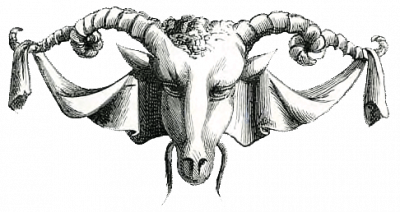
Related
Discover more from World4 Costume Culture History
Subscribe to get the latest posts sent to your email.






